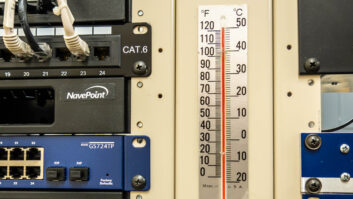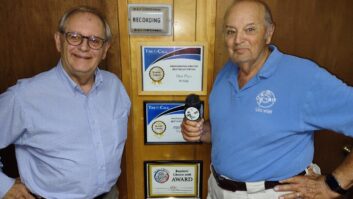Tips on rack mounting, RE-20, studio head room, and tape machine maintenance
Dec 1, 2007 12:00 PM, By John Landry, CSRE

Remote rack mounting
With the new year comes the time to gear up for remote season. Rack mounting equipment is convenient, but when it comes time to ship that rack the mounting will not hold up well to shock and stress. On many of my remotes, I need to mount gear originally intended for desk top use in a rack. Many manufacturers make adapter kits, but many of them are of poor design and often will not survive more than one trip. The photo at right shows a desktop distribution amplifier that I mounted to a Middle Atlantic 2RU rack shelf. What is different is the original rubber feet on the amplifier (which have through holes in them) act as bushings (similar to the way a car’s engine is mounted). I have found this to be the only way to mount these particular amplifiers. And experience has found this method to outlast the manufacturers accessory rack mount.

From the Tech Tips Mailbag
From Minnesota, DH writes a suggestion to help keep a 6-inch Atlas desk mic stand steady when it is holding an RE-20. DH removes the three rubber feet from the bottom of the stand base and glues an anti-slip rubber mat to the bottom. After the adhesive dries (he suggests Starbrite liquid electrical tape), he uses a utility knife around the base so the rubber mat is not visible. It appears to us that is not only an improvement for steadiness but also an improvement acoustically � the rubber mat probably helps keep rumble from the table out of the mix.
DH should also be aware that Electro-Voice has made several different mounting schemes for the RE-20. The mount shown in Figure 1 is the preferred one for mounting on a short desktop stand. The �cage� mounting (the 309A) is meant to be suspended from a boom. EV, AKG, Shure and most other mic manufacturers maintain on-line parts lists. Consult them if you run into mics you can’t control. You probably don’t have the right parts.
Studio head room
No matter how many times we measure an empty studio before construction, and even though we have CAD programs that can calculate clearances, there always seems to be a head room issue. Not electronic, but a physical one with hanging speakers. And more often than not, either one of the talent using that room or a guest will not fit below the speakers. For one solution, don’t think industrial, think preschool. Cardinal Gates is a specialty manufacturer of childproofing accessories. The company also has an excellent speaker bumper. It is called a Corner Cushion, and is available in several colors. In addition, the company manufactures a rubber moulding that can cushion soft edges of any cabinet or other surface that juts out in the way.
Tape machine maintenance
I discussed analog tape machine maintenance in the last two issues, and a few readers have e-mailed to ask about sources for replacement rubber pinch rollers. I suggest Terry’s Rubber Rollers. Terry can rebuilt just about any pinch roller or idler wheel (such as those used in a QRK or Russco turntable) and he has on-the-shelf replacements for many of the professional tape machines such as Otari and Studer. For cart machines, a suitable replacement for the ITC Delta and 99 machines is available from McMaster-Carr. The Delta roller is part number 2483K12.
Cardinal Gates
www.cardinalgates.com
Terry’s Rubber Rollers
www.terrysrubberrollers.com
McMaster-Carr
www.mcmaster.com
Do you have a tech tip? Send it to us at radio@RadioMagOnline.com.







